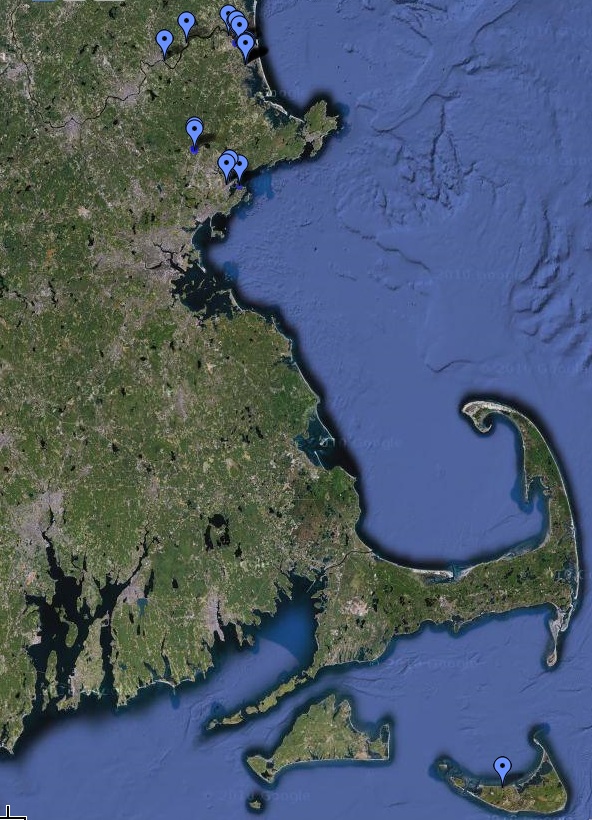Salem was the first permanent town in the Colony of Massachusetts. It was started in 1626 by Roger Conant, who brought the remaining settlers from a failed community on Cape Ann. One of those who arrived with Roger Conant was Rev. JOHN LYFORD, our ancestor who is described in the chapter on Hingham. JOHN stayed in Salem less than one year, and almost tore the new community apart when he tried to persuade everyone to come with him to Virginia. The settlement grew steadily and without much strife in the early years, and without any problems with the Indians. The land across the bay was originally a part of Salem, but was split off in 1648 to become the town of Marblehead. The principal means of transportation between the two communities was a ferry. To the northwest of the old town of Salem, smaller settlements grew within the border of Salem. One of these was called Salem Village, and eventually split off as the towns of Danvers and Middleton.
Lynn lies to the south of Salem. It was first settle in 1629, and incorporated two years later. It was eventually broken up into Reading, Lynnfield, Saugus, Swampscott, and Nahant. The tannery and shoe-making industries started in Lynn in 1635. They made all of the boots for the Continental Army during the Revolutionary War.
Ipswich lies north of Salem on the Ipswich River, just to the south of Newbury. It was first investigated in 1630 by the flagship of John Winthrop, first governor of the Massachusetts Bay Colony. His son, John, settled the site in 1633 along with 12 other men. It was incorporated a year later in 1634, the year our ancestors arrived there. The early pioneers were farmers, fishermen, and shipbuilders, with the Ipswich River providing water power for mills.
Newbury was first settled on the north bank of the Parker River in 1635. About 58 4-acre lots were laid out on the banks of the river and around a green of about 30 acres, with much larger lots granted elsewhere for farming. As it was throughout the colonies, the Indian presence was minimal due to prior smallpox outbreaks. However the town was in a perpetual state of worry about Indian attack because the settlers were so far from the main colonies of Salem and the Boston area. In 1646 the town center shifted north several miles to the Merrimack River, where Newburyport is currently located. The inhabitants of the old town were swapped land in the new town, while many new settlers were granted 8 acre lots. This shift was not without strife. When the meetinghouse was dismantled from near the Lower Green and moved, along with the graves around it, to the new town, several original settlers who lived in the old town complained, first about the expense (they had spent money to build it originally, whereas the new settlers in new town got it for free), and second about the lack of a church for them to attend. However their arguments were ignored, and over the years the new town has become the thriving town center of Newburyport, while the old town is now little more than a quiet residential and farming area. To the northwest of Newbury is Haverhill, and across the river to the northeast is Salisbury.
Andover was first settled in 1641, but our first ancestors did not arrive until 1818. By then Andover was a manufacturing center with a number of mills along the Shawsheen River.
In the following descriptions, the direct ancestors (not including siblings) are given in capital letters.
|-Robert Muzzy
|-Joseph Muzzy -|
| |-Bridgett Bradstreet
Benjamin Muzzy-|
| |-James Jackman
|-Esther Jackman-|
|-Joanna
Our earliest ancestors to permanently settle on the north shore of Massachusetts were the MUZZY family. ROBERT MUZZY married BRIDGETT BRADSTREET in England, and had at least four children born in England: JOSEPH, Benjamin, Mary, and Ellen. In 1634 the family came to Ipswich with ROBERT's brother John. ROBERT was admitted a freeman September 3, 1634, and was on the committee to assign lands. Early maps of the town show that ROBERT owned two one-acre parcels in the town. One of these was sold to Matthew Whipple; the other was bequethed in ROBERT's 1642 will to his wife. The will also mentions 26 acres on the south side of Egypt River including a farm he bought of John Newman. Six of those acres went to his wife, and 20 went to his oldest son, JOSEPH. ROBERT died in 1644, and the family soon left Ipswich. His wife BRIDGETT remarried twice, first to Thomas Rowlandson of Lancaster, and when he died in 1657, to William Kerley, Senior. BRIDGETT died June 14, 1662 in Lancaster. JOSEPH is mentioned in the Ipswich court records in 1651 and again in 1664, but we can not be sure when he moved to Newbury. His marriage to ESTHER JACKMAN, 23 years younger than him, is recorded in the Vital Records of Newbury, along with the deaths of two of their children in 1676. He is recorded in 1678 as to having taken the oath of allegiance at Newbury. He lived in what was called Muzzey's lane, now called Marlboro St., in Newburyport. He wrote his will July 29, 1680 and mentions a daughter Mary and a son Joseph, to whom he gives the majority of his estate. He also mentions that his wife is pregnant, and that if the child survives, it is to receive 10 pounds each from his wife and son Joseph. This child, who was born four months before JOSEPH died, was our ancestor BENJAMIN MUZZY. JOSEPH's estate was valued at 162 pounds. Since all of the children were young, ESTHER was given possession and use of the entire estate during her life, and upon her death son Joseph was to be given half of the estate while Mary and BENJAMIN were each to be given one quarter.
We do not know much about ESTHER JACKMAN's parents, JAMES and JOANNA JACKMAN. They first appear in the records of Newbury in 1651 when he purchased land from Giles Abbots. In 1652 Edward Rawson sold land to Richard Bartlett which was bounded on the south by the highway, on the west by JAMES JACKMAN, and on the north by Samuell Poores. JAMES also appeared on various lists such as a tax list and a tithing list. In 1666 he signed a petition immediately below the signature of JOSEPH MUZZY, his future son-in-law. The JACKMANs had three daughters and two sons. He died in Newbury in 1694. We don't know what happened to JOANNA or to ESTHER; they probably both lived in Newbury until they died.
BENJAMIN probably grew up in Newbury, and then moved to Lexington when he was old enough to be on his own. His cousin Benjamin, 23 years older, had moved to Lexington by 1683 and owned considerable land there. The first reference to our ancestor BENJAMIN in the Lexington records was in 1705, when he was denoted as Benjamin Jr. His life there is described in the Lexington chapter.
|-Henry Coombs
Deborah Coombs-|
|-Elizabeth
Rumor has it that HENRY COOMBS might have been born in France, but that he immigrated to Massachusetts from England. He was a proprietor in Salem in 1635. In 1648 when the town decided to split off Marblehead to be a separate town, HENRY bought 6 acres of land in the new town where he lived the rest of his life as a fisherman. He became way-warden at Marblehead in 1656, and was in charge of the Marblehead ferry in 1661 (his land was less than 1/2 mile from the ferry dock). In 1667 a complaint was made against HENRY for saying that Mr. Walton, the schoolmaster and acting minister at Marblehead, "preached nothing but lies and he could prove him to be a knave". His life ended suddenly two years later when he drowned. An inquest was made into the cause of his death, and the jury of 12 returned a verdict Aug 30, 1669 that HENERYE COMBES was drowned by accident, being drunk.
Since HENRY died intestate, ELIZABETH was appointed administratrix, and she brought in an inventory, which was allowed. She was to have the whole estate of 85li. 5s. 6d. after the debts of 57li. 2s. 8 1/4d. were paid to 21 people. The inventory included: "Dwelling house, six acres of land upon which the house standeth, orchard, garden, corne land & wast unimproved land; one cow & one heifer; 3 swine of a yeare old & 4 smaler swine; pcell of Corne, with other frutes growing there; a smale boate; 2 loads & halfe of haye; the garden fruite & aples upon the trees; wearing apparrell with 1 pr. stockins; beading, bedstedd & old curtins & som linen; 3 pewter dishes, 6 poringers, a bason, chamber pot, a salt, suck botle, 5 drinking cups; earth ware; warming pan & lanthorne; 2 Iron pots, a skellet, hangers, tongues, gridiron, friing pan; 2 spining sheeles, a box & a chest, 4 old chaires, a stoole, bellowes; axes, reap hoockes, old howes & pails."
ELIZABETH lived another 40 years. She conveyed a half acre of their land to her daughter Susanna and her new husband Francis Grant on May 4, 1670. She remarried Stephen Griggs, a much younger man who was about the age of her oldest child. The Coombs had seven children in total, including their 3rd child DEBORAH who married on Aug 15, 1682, in Marblehead, JOSEPH GANNETT of Scituate. Read more about the Gannett family in the chapter on Hingham.
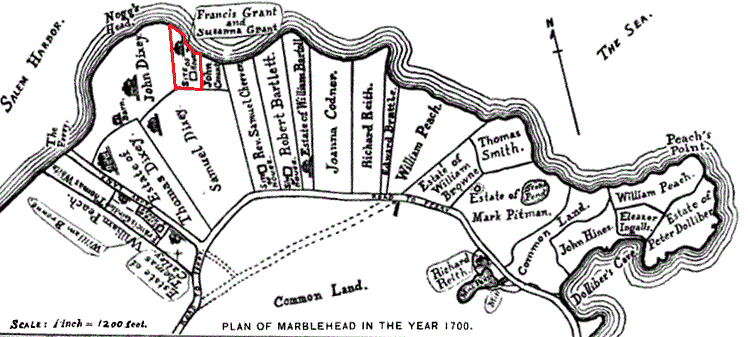
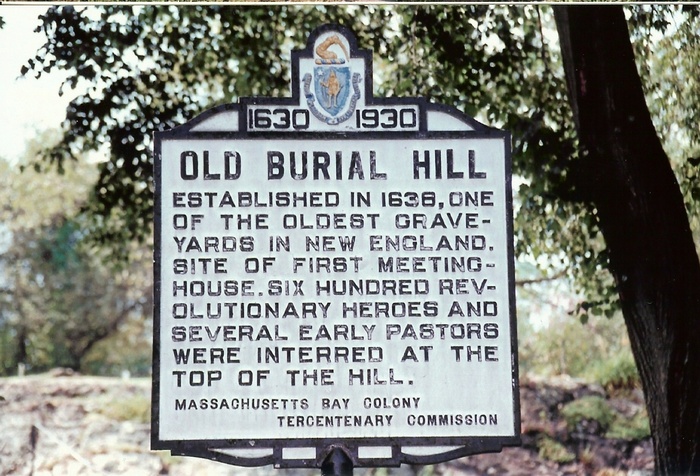
|-Edward Howe
William Howe-|
|-Elizabeth Rastell
The HOWE family left London on September 19, 1635 on the "Truelove": EDWARD HOWE, husbandman, aged 60; ELIZABETH HOW, aged 50; and five children, including WILLIAM, aged 6. They settled in Lynn, where EDWARD became a freeman in 1636. From 1637 until his death two years later he was a Magistrate at Salem Court and a Deputy for Lynn to the Massachusetts Bay General Court. Commiserate with his position, he was granted 210 acres in the 1638 division of land at Lynn. He died in April of 1639 waiting for the ferry to Boston. Governor Winthrop reported that "one Mr. Howe, of Lynn, a godly man, and a deputy of the last General Court, after the court was ended, and he had dined, being in health as he used to be, went to pass over to Charlestown, and, being alone, he was presently after found dead upon the strand, being there (as it seemed) waiting for the boat, which came soon after". ELIZABETH continued to live in Lynn, and "Widow HOW" died there in 1671. Son WILLIAM moved to Concord where his children were born. It is not known where his wife was born; she could have lived in Lynn with him, or she could have grown up in Concord.
|-Philip Knight
|
Elizabeth Knight-|
|
|-Jonathan Knight -|
Ruth Knight-| |
|-Ruth Wright |-Margery
PHILIP and MARGERY KNIGHT came to Charlestown around 1637. He was a cooper by trade. In 1651 he was granted the right to run the Penny Ferry for a year, at the rate of 2 penny for a single person, or 1 penny each for more people. The Ferry ran across the Mystic River where the Malden Bridge is now. They had five children born in Charlestown, including JONATHAN and ELIZABETH, both of whom are our ancestors (JONATHAN's grandson married ELIZABETH's granddaughter in Concord around 1740). MARGERY was admitted to the Charlestown church May 7, 1650. The KNIGHTs then lived in Lancaster, where PHILIP owned land from 1654 (the year Lancaster was incorporated) until he sold it by 1659. The Knight family finally moved to Topsfield probably around 1659, where the parents died in 1668 and 1670. PHILIP's estate lists his five children and an inventory of his possessions totaled 106li. 18s.: "Two cows, two oxen, two steres, two young cattle, one mare, five swine, feather bed with furniture, puter, wereing clothes, wooding lumber, Beefe & porcke, Irron were, Brasse were, Indian Corne, Rie & Barley, hoopes, hempe & flax, Cotton woole, two beeds & furniture, five pare of shetes, three pare of pillowbyes, table cloth & napkines, five sackes & winno shette, new Cloth & one Wallett."
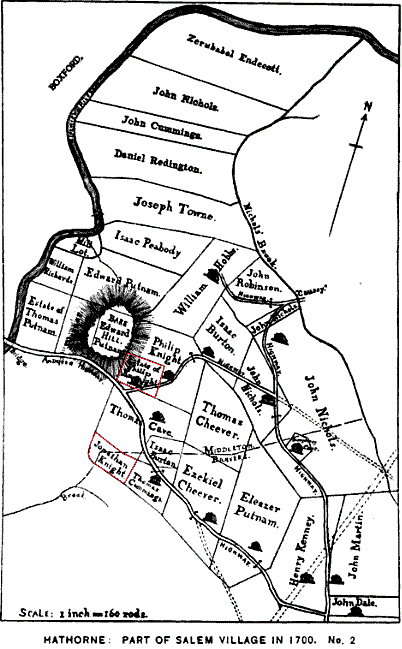
Newbury, Haverhill, Salisbury, Nantucket (1635 - 1720)
|-Richard Dole
|-Richard Dole -| |-Henry Rolfe
| |-Hannah Rolfe-|
Sarah Dole-| Anna Rolfe -|
| |-Honor Rolfe
|
| |-Edmund Greenleaf
| |-Stephen Greenleaf-|
| | |-Sarah Moore
|-Sarah Greenleaf-|
| |-Tristram Coffin-|
|-Elizabeth Coffin -| |-Joanna Kember
|-Dionis Stephens
|-Tristram Coffin-|
|-Elizabeth Coffin -| |-Joanna Kember
|-Dionis Stephens
Four separate ancestor families ended up in the settlement of Newbury. The Coffin family is one of the most unique and interesting of our ancestors, and we will start with them. TRISTRAM COFFIN came after the death of his father. Only 33 years old, he was responsible for a large extended family: his wife DIONIS, their five children including ELIZABETH, his two sisters, and his mother JOANNA. Unlike most of our other ancestors and the majority of the immigrants in The Great Migration who were Puritans, TRISTRAM was a royalist, who left England because of the success of Oliver Cromwell and the Puritan parliament. He came with his friend Robert Clement, who owned the boat that brought them here. The ship landed at Salisbury in the spring of 1642, and that summer the two friends settled near each other in Haverhill, a few rods east of the burial ground. TRISTRAM became a freeman in 1642, and on Nov 15, 1642 he was a witness to the Indian deed selling the land to the town of Haverhill, and his signature shows he was literate. This was also a struggle of survival for the family: one son died October 30, followed two weeks later by the birth of a daughter on November 15, only to see her die on December 30. The next year the Coffins and Clements moved to Rocks' Village, at the eastern end of Haverhill, where TRISTRAM is considered to be the first to use the plough in Haverhill. He is included in a list of 32 settlers in Haverhill in 1645, and the births of a son is recorded in Haverhill in 1647. Around then the family moved to Newbury on the south bank of the Merrimack River. In 1647 TRISTRAM was authorized by the General Court to keep the ferry over the river from the Newbury side, between Carr's Island and Ram Island, and he was allowed to keep an "ordinary" (tavern) where he could sell wine. In 1652 the record again shows that he was allowed to continue the ferry "as long as the Towne shall see cause", charging two pence a person one-way, and four pence a beast. DIONIS probably ran the ordinary. In 1653 she was cited for selling beer for 3 pence per quart, above the allowed 2 pence. However she was acquited when she convinced them that she had used 6 bushels of malt rather than the standard 4, to make a better beer, and priced it accordingly.

At some point the family moved across the river to Salisbury. TRISTRAM was a commissioner of Salisbury in 1654-55, and he paid taxes there in both 1652 and 1659. In Newbury, he owned 80 acres along the river, 40 of which he sold in 1657 to the west of the current Jefferson St. in Newburyport. The other 40 was to the east of Jefferson, and probably included his house and the ferry terminus. There is a short street there now called Coffin St. In 1659 while living in Salisbury, TRISTRAM made an exploratory trip to Nantucket Island; he liked what he saw, and in July, he led a group of nine investors, including himself, his son Peter, and his son-in-law STEPHEN GREENLEAF (who married daughter ELIZABETH in 1651), in buying the island from Thomas Mayhew, who held the grant for the land. He also paid £5 for Tuckernuck Island, just to the west of Nantucket. He moved to Nantucket in 1660 along with his wife and four of his children. The following year he bought the land from the Indians, and was appointed the first chief magistrate at Nantucket. The family lived adjacent to Capaum Harbor; TRISTRAM was the patriarch of the island, and the richest person there except for his son Peter. He farmed and maintained a mill that he built. He was respected by the Indians, some of whom he hired for various jobs. He died on the island in 1681, followed by his wife in 1684. In 1728 somebody tabulated all of his descendents and found 1582 descendents, of which 1128 of them were still alive.
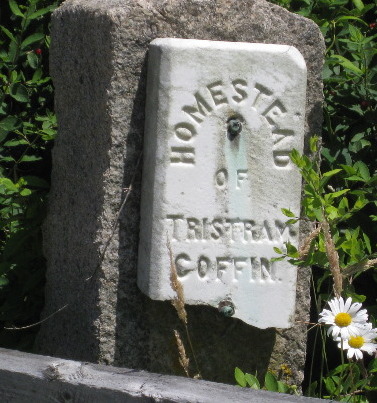


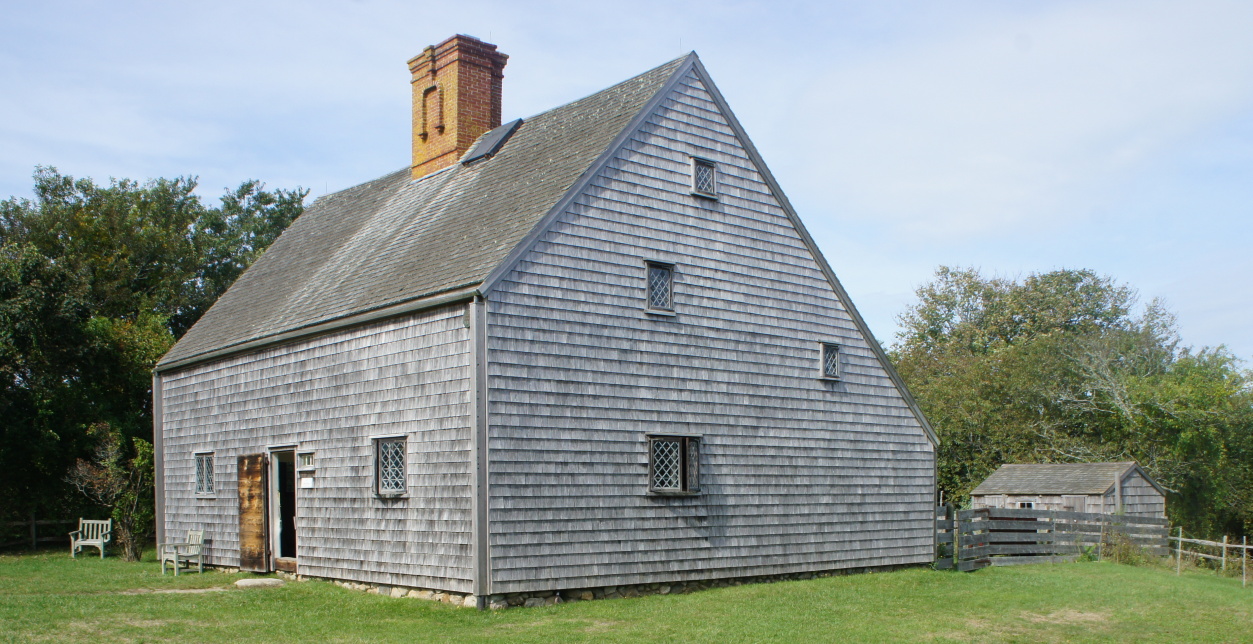
Middle: signs in the Whaling Museum on Nantucket; the map locates the land of our ancestors Tristram Coffin (in red) and his son-in-law Stephen Greenleaf (in green), who never lived on Nantucket.
Right: Jethro Coffin House built in 1686.
TRISTRAM was integral to the early history of Nantucket, and many history books mention facets of his life there. One of the major reasons he started a new community on Nantucket was to get away from the demands of the Puritan philosophy, rampant in the Colony of Massachusetts, that required strict conformity to Puritan teachings. He was upset with the banning (and in some cases hanging) of Quakers. He insured that no organized religion or paid minister became established on Nantucket, though he certainly read the bible and participated in the informal religious observances they had on the island. His daughter, Mary Coffin Starbuck, eventually helped Quakers to form the first and most predominate church on Nantucket for over a century. TRISTRAM was also the head of a major feud that developed between the Coffin family and the Gardner family over who would control the political life of the community: the original proprietors who owned most of the land, or the "half-share men" who were basically tradesmen brought to the island to insure that there were a broad range of specialists to allow the island to be self-sufficient. This feud lasted until 1686, when TRISTRAM's grandson Jethro married a Gardner woman, and the feuding factions were united. As a wedding present, the couple got land from the Gardner side, and lumber and building supplies for a house from the Coffin side. They were married in the resulting house, which still exists as a museum called "The Oldest House". Although our ancestors never lived in the house, it is well worth visiting as an example of how our 17th century ancestors lived.
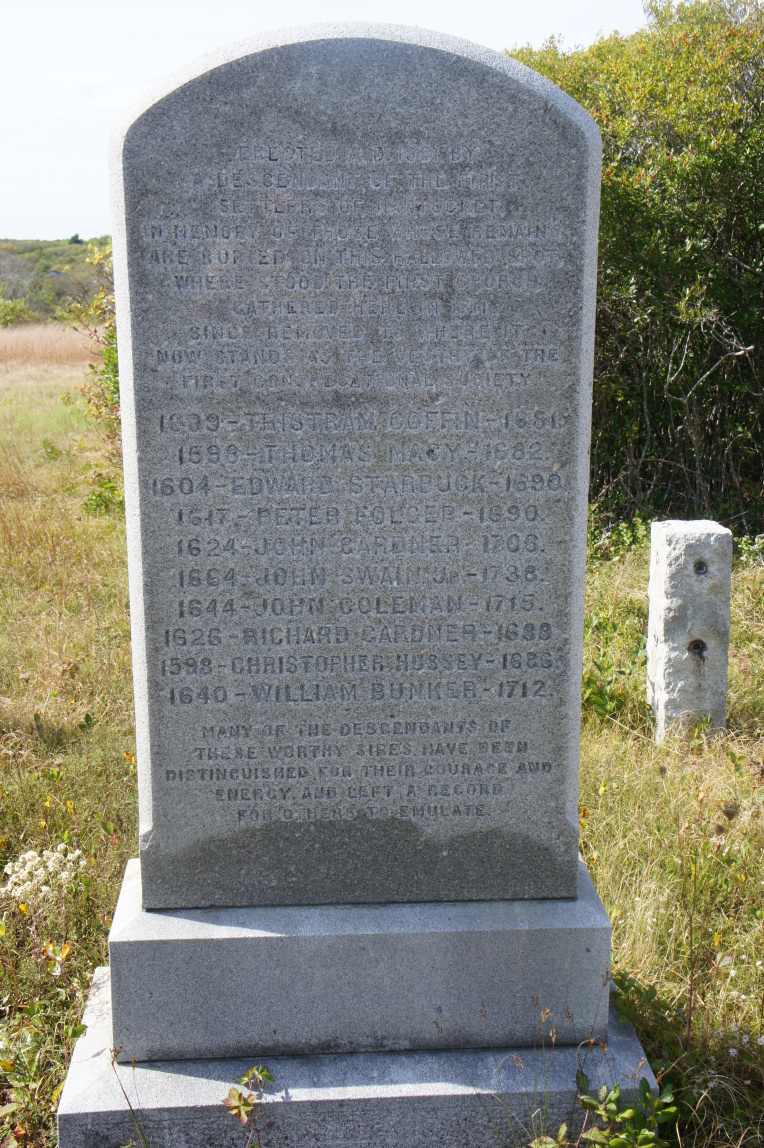
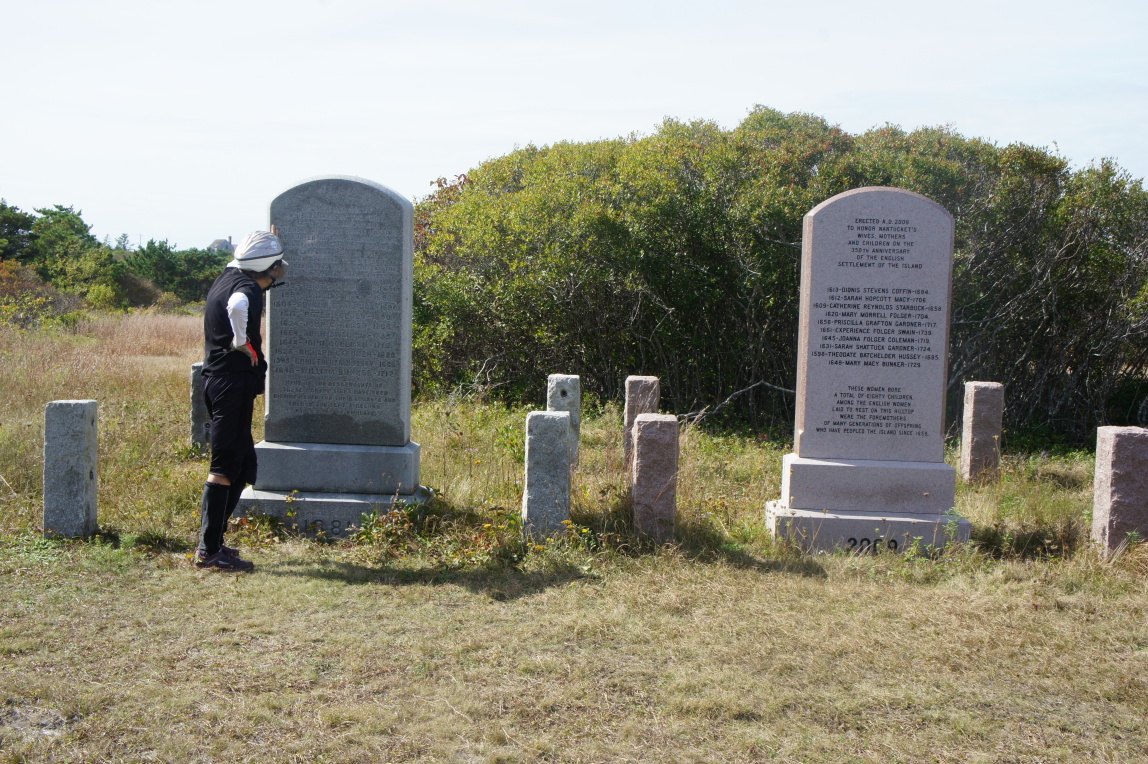
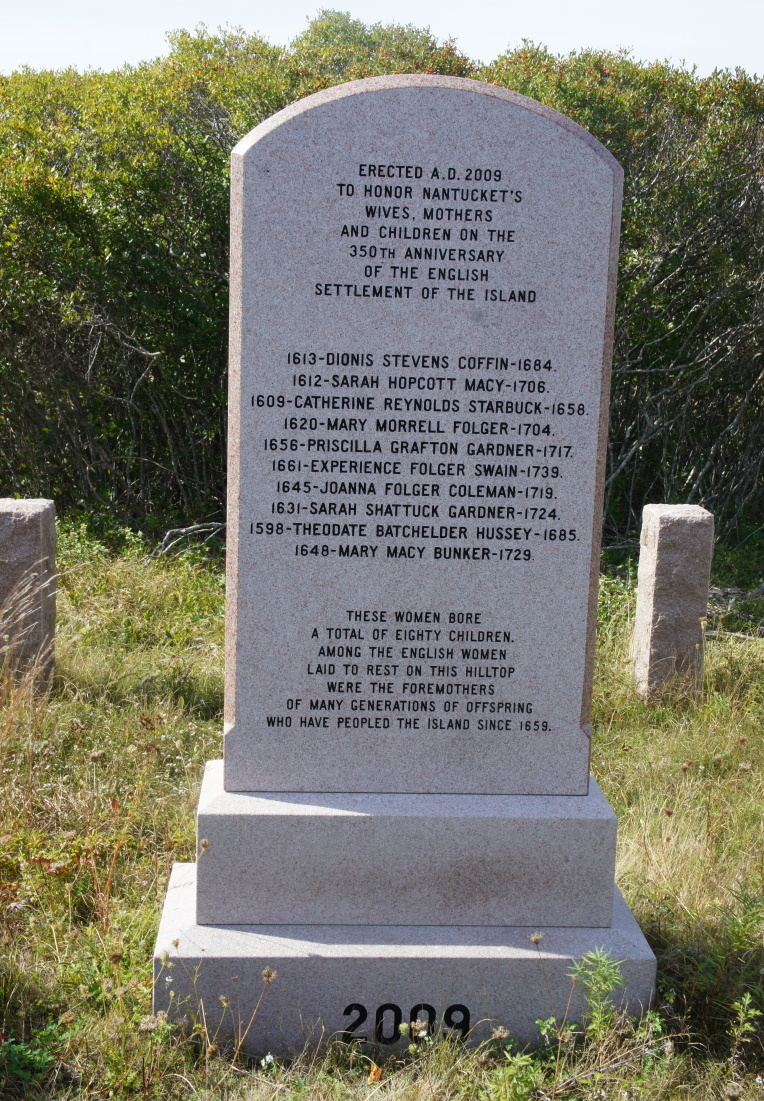
Founders Burial Ground
ERECTED A.D. 1881, BY | ERECTED A.D. 2009
A DESCENDANT OF THE FIRST | TO HONOR NANTUCKET'S
SETTLERS OF NANTUCKET | WIVES, MOTHERS
IN MEMORY OF THOSE WHOSE REMAINS | AND CHILDREN ON THE
ARE BURIED ON THIS HALLOWED SPOT, | 250th ANNIVERSARY
WHERE STOOD THE FIRST CHURCH | OF THE ENGLISH
GATHERED HERE IN 1711, | SETTLEMENT OF THE ISLAND
SINCE REMOVED TO WHERE IT |
NOW STANDS AS THE VESTRY OF THE | 1613-DIONIS STEVENS COFFIN-1684.
FIRST CONGREGATIONAL SOCIETY. | [nine other names and dates]
|
1609 - TRISTRAM COFFIN - 1681 | THESE WOMEN BORE
[nine other names and dates] | A TOTAL OF EIGHTY CHILDREN.
| AMONG THE ENGLISH WOMEN
MANY OF THE DESCENDANTS OF | LAID TO REST ON THIS HILLTOP
THESE WORTHY SIRES HAVE BEEN | WERE THE FOREMOTHERS
DISTINGUISHED FOR THEIR COURAGE AND | OF MANY GENERATIONS OF OFFSPRING
ENERGY, AND LEFT A RECORD | WHO HAVE PEOPLED THE ISLAND SINCE 1659
FOR OTHERS TO EMULATE. | 2009
TRISTRAM's mother JOANNA never lived in Nantucket. At some point while TRISTRAM was living in Haverhill, Newbury, or Salisbury, she moved to Boston with her two daughters, one of whom married a Boston man. She died in Boston in 1661. TRISTRAM's son, Tristram Jr., married in 1653 and moved to his wife's home on High St. in Newbury. Tristram Jr. built a large home there that still exists as a museum, called the Coffin House. TRISTRAM Sr. is said to have lived in the house shortly before he moved to Nantucket, and he would have stayed there whenever he visited Newbury from Nantucket. One block to the northwest of the house is a short street called "Coffins Ct" and three blocks to the southeast of the house is a major street called "Rolfe's Ln". Tristram Coffin, probably the son, was witness to JOSEPH MUZZEY's will, signed July 29, 1680.
|-Edmund Greenleaf
|-Stephen Greenleaf-|
| |-Sarah Moore
|-Sarah Greenleaf-|
|
|-Elizabeth Coffin
Two of our ancester families, Greenleaf and Rolfe, are shown on a plan of lots laid out to the first settlers of Newbury in 1635. CAPTAIN EDMUND GREENLEAF was one of our oldest immigrants, having been born Jan 2, 1573/4. He came with his wife SARAH and their nine children to the new settlement of Newbury on the banks of the Parker River. He was granted a 4-acre lot about 150 yards from the river, near the current bridge. Over the years he acquired a total of 122 acres from grants; only 10 other settlers acquired more. He was admitted a freeman in 1639, and also in that year was "permitted to keep a house of entertainment" (tavern), which license he had until 1650. Initially, the tavern might have been in his house in the old town, but he probably moved it closer to the new town where more people soon lived. In 1653 he sold one acre of land with a still-house and fixtures connected therewith that was next to a tavern owned by Stephen Swett on the west side of High St near the head of Marlborough St.
EDMUND was active in the militia the entire time he was in Newbury. He was made an Ensign in 1639, a Lieutenant in 1642, and a Captain in 1645 before retiring in 1647. At least once during this time he commanded a unit that went after an Indian threat. In 1646 he was the first signer of the petition complaining about the moving of the meetinghouse to the new town. Shortly after this, probably in 1650 when the records show his tavern license was given to someone else, he and his wife moved to Boston where he was a silk-dyer by trade, with his dyehouse "by the spring". When SARAH died in 1663, he remarried Mrs. Sarah Hill, but had an unhappy marriage with her and her children. He died in 1670, with an estate of £131.5.9. (See the Boston chapter for more on Edmund, or click here for the Edmund Greenleaf will)
EDMUND's son CAPTAIN STEPHEN GREENLEAF, born in England about 1628, married ELIZABETH COFFIN in Newbury on Nov 13, 1651. All of their ten children were born in Newbury, including SARAH in 1655. When ELIZABETH died in 1678, STEPHEN remarried the following year to Mrs. Esther Swett (probably part of the Swett family that owned the tavern next to EDMUND GREENLEAF's tavern). He bought 12 acres of land with house and barn from John Bond on Nov 20, 1660. This land was bounded by the current High, State, and Green Streets in Newburyport. He gave his son Stephen Jr the upper end of the lot (along High St.) soon after the son married in 1676. STEPHEN became a freeman in 1677, a member of the 1st Congregational Church in Newbury in 1674, a selectman in 1675, a Representative to the General Court from 1676 to 1686, and a member of the Council of Safety in 1689. Several times he was listed as performing an inventory for the estate of a deceased person, and in 1687 he helped lay out a tract of land. Following the footsteps of his father, he became an Ensign in 1670, Lieutenant in 1685, and Captain of the Militia in 1686. During the French and Indian Wars, he was a part of an expedition under Sir William Phips consisting of 2000 men in 30 or 40 vessels. They attacked Quebec in October of 1690, but after several failed attempts and with storms approaching, the expedition headed home. Several vessels were lost in the storms; one was wrecked on Cape Breton, drowning ten men including STEPHEN. Before the start of the expedition, STEPHEN wrote his will, in which he gave the rest of his land to Stephen Jr and to son Edmund. Another son, John, bought five acres of adjacent land to the northeast in 1692, so the three sons owned a total of 17 contiguous acres in the center of Newburyport.
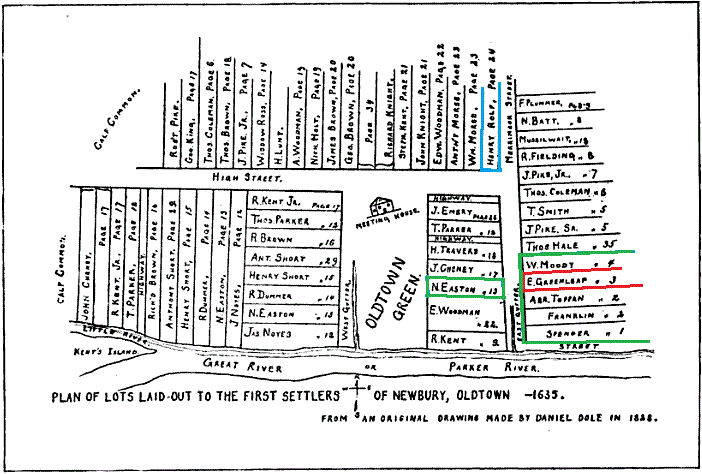
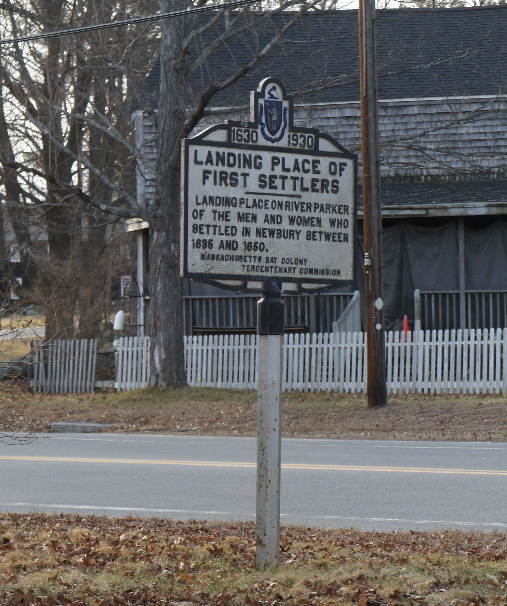
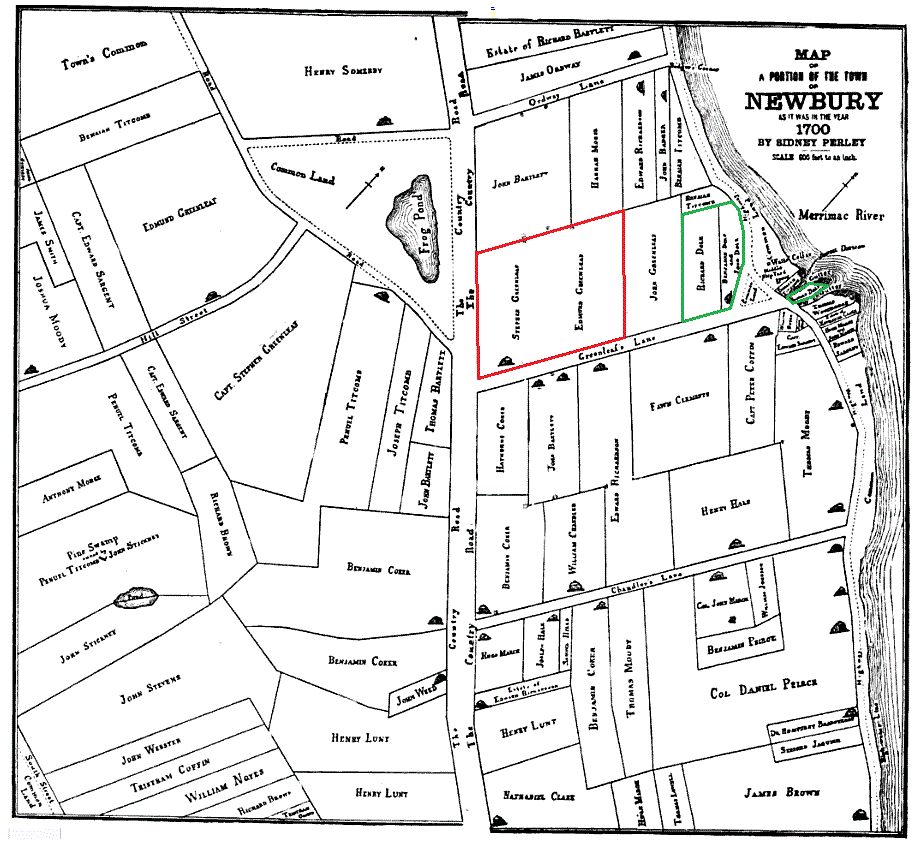
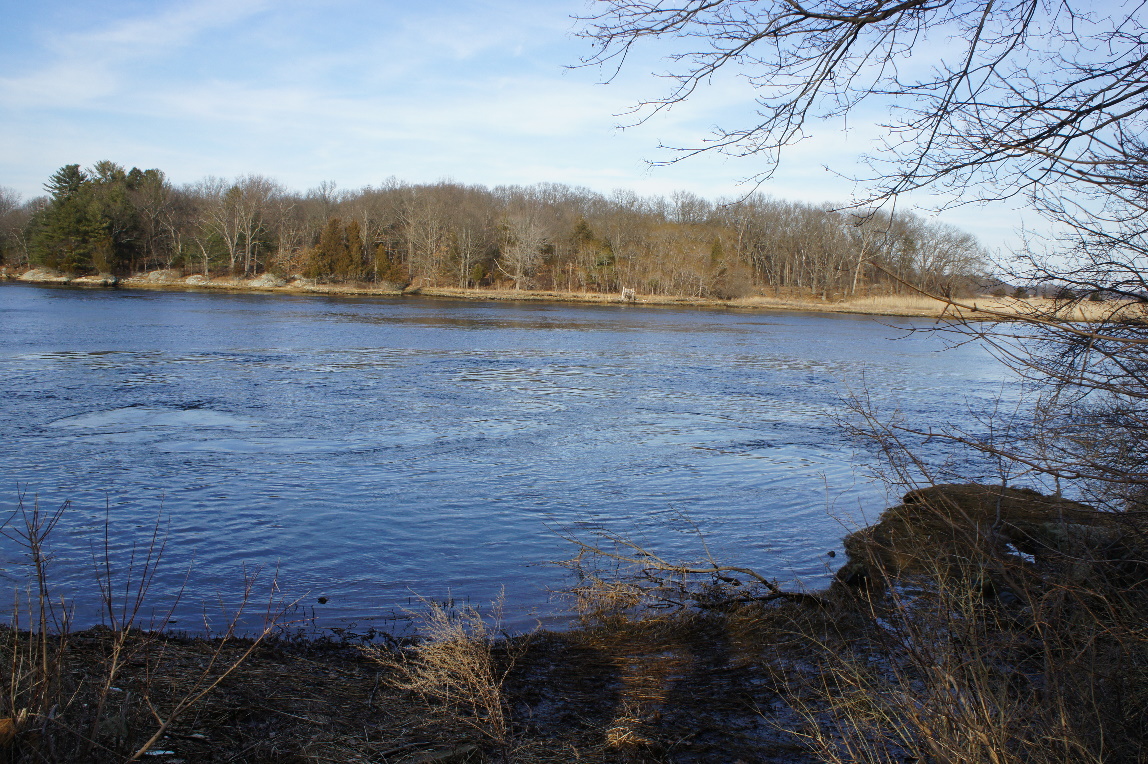
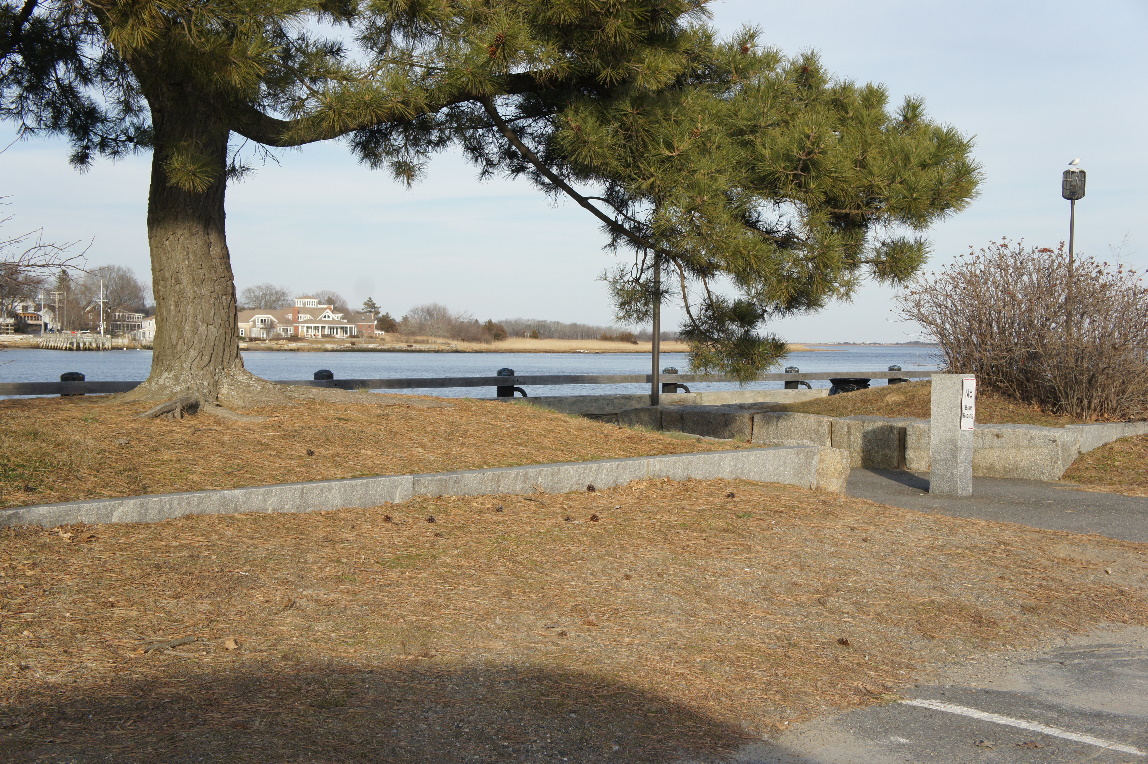
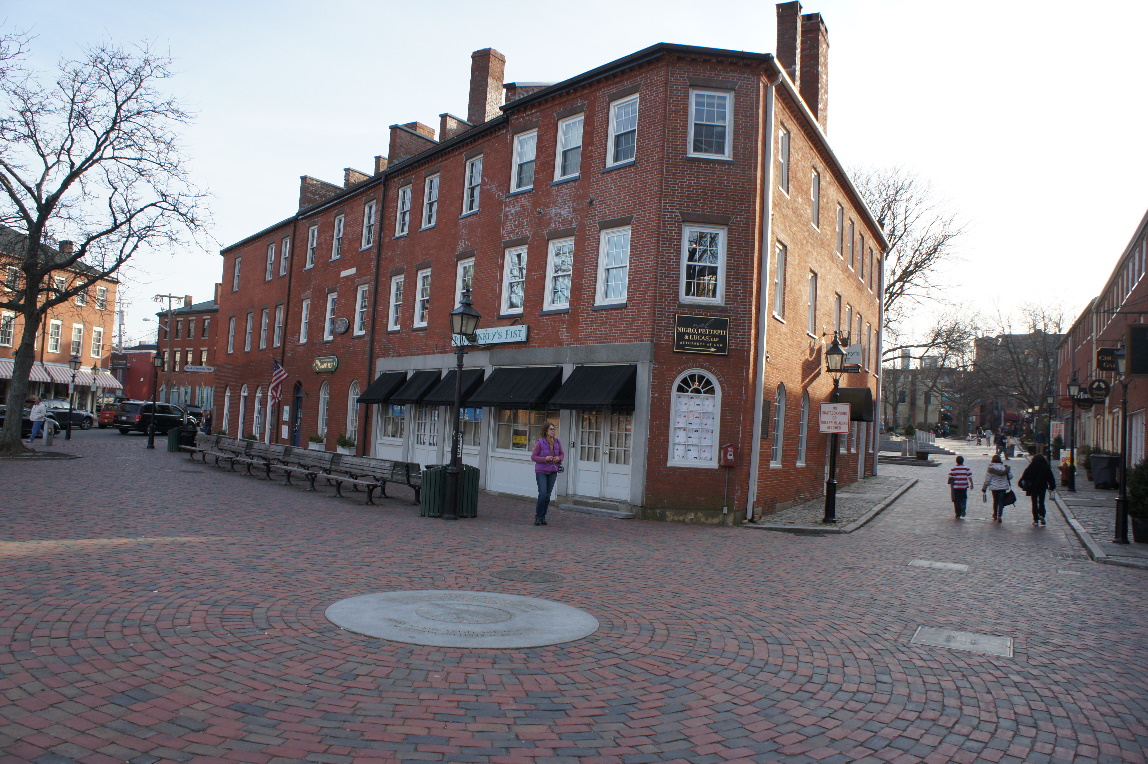
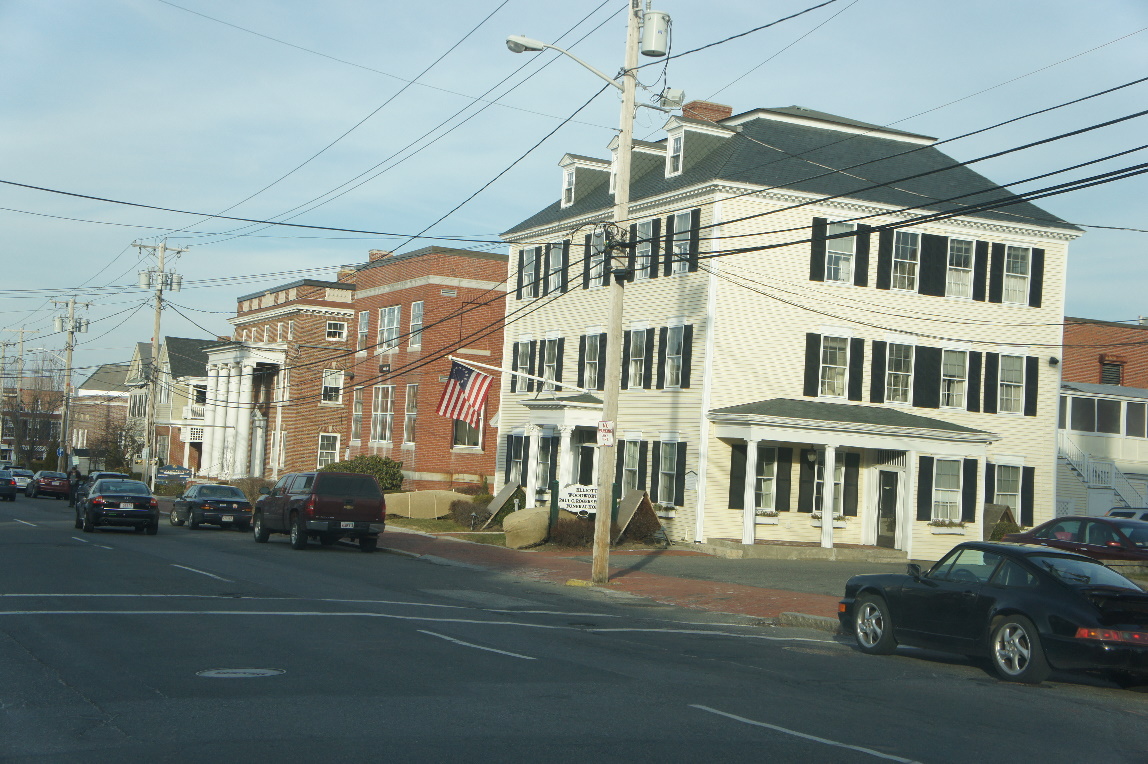
2. Merrimack River where Richard Dole's dock was located.
3. One corner of Richard Dole's land. It currently is the biggest commercial center in downtown Newburyport.
4. One side of Stephen Greenleaf's land. Currently it contains scores of large homes within a half dozen blocks of the commercial center in Newburyport.
|-Henry Rolfe
Hannah Rolfe-|
Anna Rolfe -|
|-Honor Rolfe
The other original ancester family that came to Newbury by 1635 was the Rolfe family. HENRY ROLFE and his wife HONOR ROLFE were cousins of each other: HENRY's father JOHN was the brother of HONOR's maternal grandfather. Also HONOR's parents were second cousins of each other. It is not surprising then, that two of their great grandchildren married: WILLIAM JOHNSON of Woburn and SARAH DOLE of Newbury. HENRY and HONOR had four children: John, ANNA, and HANNAH born in England, and Benjamin probably born in Newbury. HENRY's brother John, John's wife, and their nephew Thomas Whittier came to Newbury in 1638 on the ship "Confidence". The Rolfe's were here less than a decade when HENRY died in 1642/3. His will
(Henry Rolfe will)
bequeathed his house and land to his oldest son John. The rest were to be divided among his other children and wife, with his wife getting some large brass kitchen ware. He also gave his swarm of bees to nephew Thomas Whittier.
Soon after HENRY died, his two daughters married: ANNA married Thomas Blanchard of Charlestown and HANNAH married RICHARD DOLE of Newbury. HONOR died December 19, 1650, while at the Blanchard home [Thomas also died two months later - perhaps from the same disease]. She did not have a written will, but while she lay sick in bed two days before dying, she gave an oral will with two witnesses "of Charlestown". These two men then each gave a (deposition) the day after she died indicating her requests. Most of her belongings went to her son Benjamin, with some linens and the brass kitchen ware mentioned in HENRY's will split between the two daughters. She gave 20 shillings apiece to her 4 grandchildren (each daughter had two children at this time). Within a year, ANNA re-married RICHARD GARDNER of Woburn (read more about the Gardner family in the Woburn chapter).
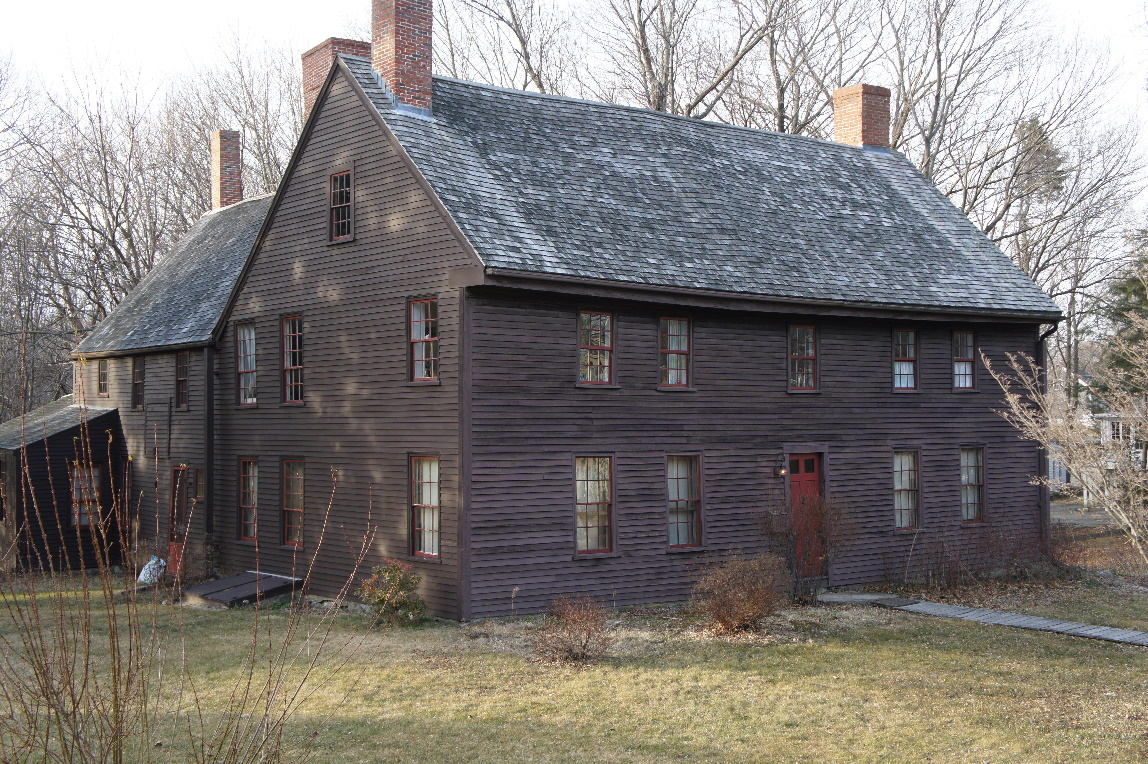
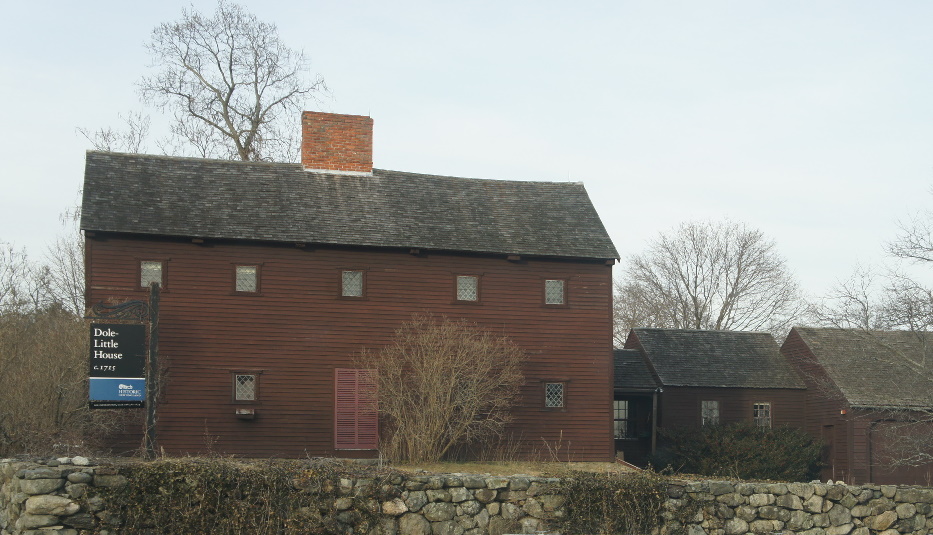
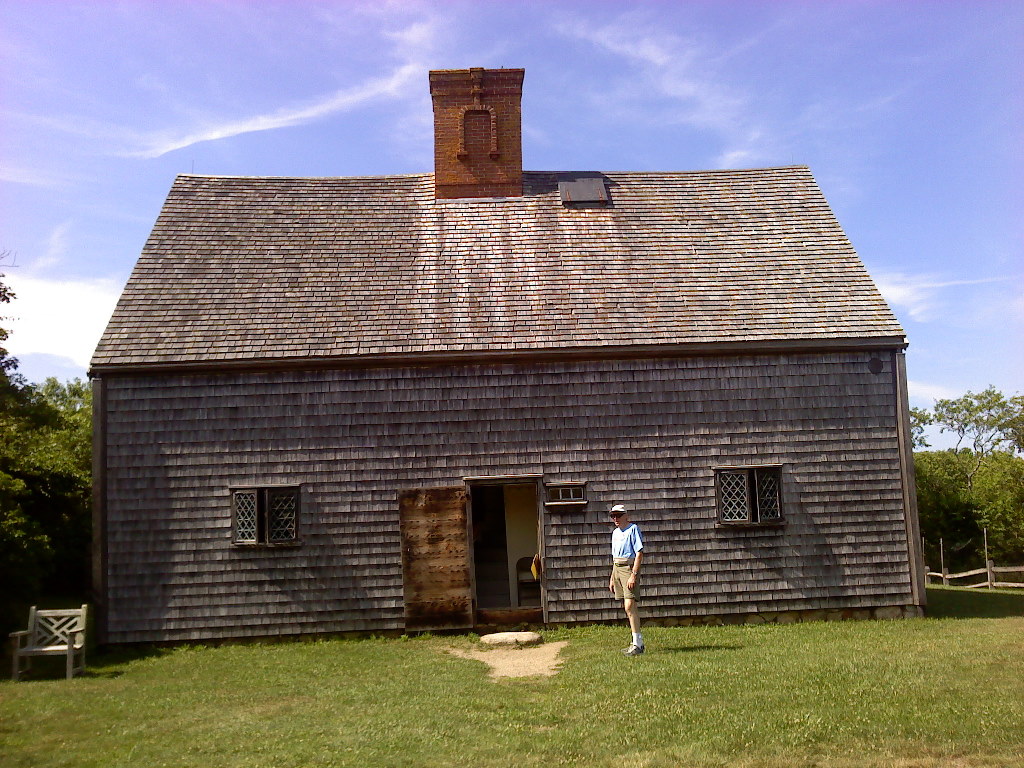
Center: the Dole-Little House ca. 1715 (Newbury)
Right: the "Oldest House" or Jethro Coffin House 1686 (Nantucket)
|-Richard Dole
|-Richard Dole -|
| |-Hannah Rolfe
Sarah Dole-|
|-Sarah Greenleaf
The RICHARD DOLE that HANNAH ROLFE married in 1647 first came to Newbury in 1639 at the age of 17. He came with his employer, John Lowell, who was a prominent man in the affairs of Newbury. RICHARD was John's clerk for a while, but eventually entered business himself and became a prominent merchant and land holder. His home was on the land originally granted Nicholas Easton, and remained in the family for six generations. The house that is currently there in 2010 is called the Dole-Little House. It was built in 1715 by RICHARD's great grandson. Nicholas Easton was a tanner, and when he bought the land RICHARD likewise took up tanning. He also bought five adjacent lots totalling 20 acres, including the original lot of EDMUND GREENLEAF. In 1674 he bought three acres from the Cromwell estate, and two months later six 1/4 rods along the Merrimac R. were laid out to him. A couple years later he built a dock there which was open to the people of Newbury to use. In 1681 he conveyed an acre of this Cromwell lot to his son Dr. John Dole, who bequethed it to his sons John and Benjamin. RICHARD died in 1705 with an estate valued at £1840. He gave half of his bark house & mill and other implements of tanning to son RICHARD Jr, and a quarter each to sons William and Abner. William also got his dwelling house and the adjacent 5 lots.
RICHARD DOLE Jr. was a merchant like his father. He grew up in the Dole house by the Lower Green, but probably moved up to the new town when his father bought a lot there. In 1677 he married SARAH GREENLEAF, who lived on the same block as the Dole lot. They had nine children, including SARAH born in 1681. RICHARD Jr. did not appear often in the records, and when he did it was mainly as a witness to what his father had said or done. One notable case occurred in 1681 in a case of the estate of Patrick Evans vs. RICHARD DOLE Sr. Evans was the master of the ship Hopewell which DOLE Sr owned. Evans drowned during a voyage, and the estate sued for unpaid wages. Also RICHARD DOLE Jr. was on board as merchant, and when the ship docked took a barrel of rum and a barrel of sugar belonging to Evans and sold them. DOLE Jr. said that Evans had promised to pay for the passage of somebody he let on the ship, and the barrels covered the passage. The verdict went against the Doles. Another mention in the records is much more favorable for the son. In 1700 he is listed as one of five grantees, all selectmen, on a deed from the Indians for the land of the town of Newbury. When he died in 1720, RICHARD's estate was valued at £1840.2 and included about 237 acres of land.
When SARAH DOLE married her 2nd cousin WILLIAM JOHNSON of Woburn in 1708, she moved to Woburn. Her parents were the last of our ancestors in Newbury, and when they died in 1718 and 1720, our ancestors' lives in Newbury ended. But we still see evidence of our ancestors' lives in the two existing houses: the Coffin House and the Dole-Little House; and evidence of their deaths in the four tombstones that still exist in the Burying Ground of First Settlers in Newbury.

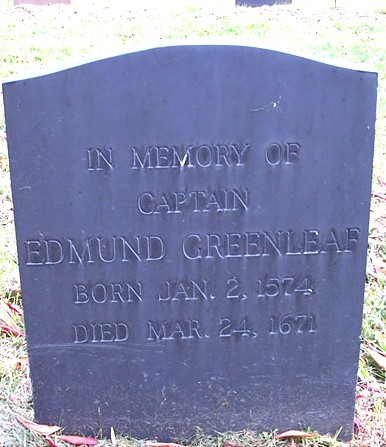
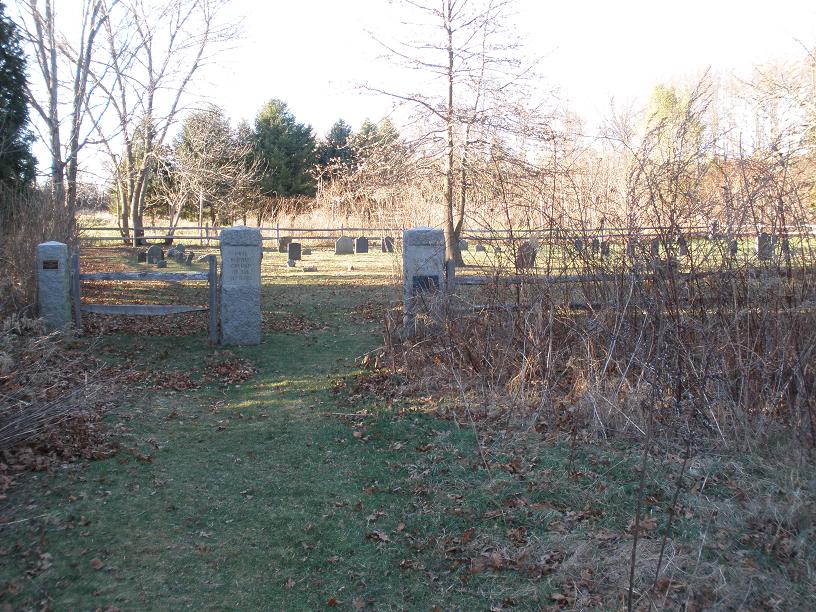
IN MEMORY OF
CAPTAIN
EDMUND GREENLEAF
BORN JAN. 2, 1574
DIED MAR. 24, 1671

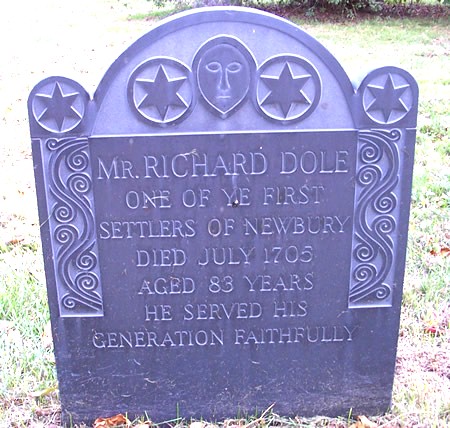
MRS. HANNAH ROLFE | MR. RICHARD DOLE
WIFE OF | ONE OF YE FIRST
MR. RICHARD DOLE | SETTLERS OF NEWBURY
DIED NOV. 16, 1678 | DIED JULY 1705
AGED 48 YEARS | AGED 83 YEARS
WE CROWN HER | HE SERVED HIS
HARDSHIPS WITH PRAISE | GENERATION FAITHFULLY
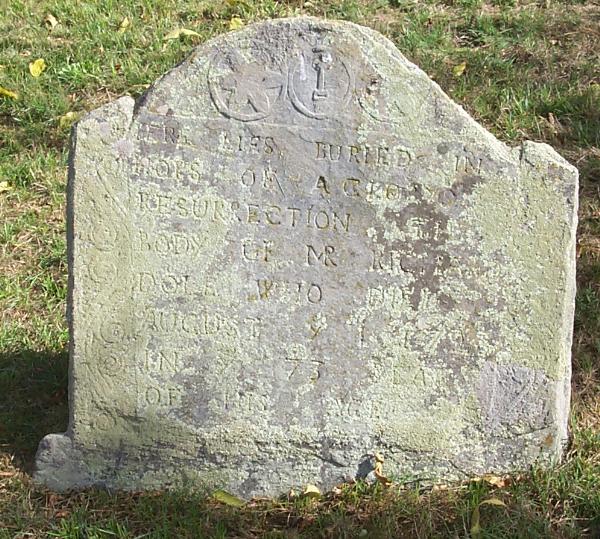
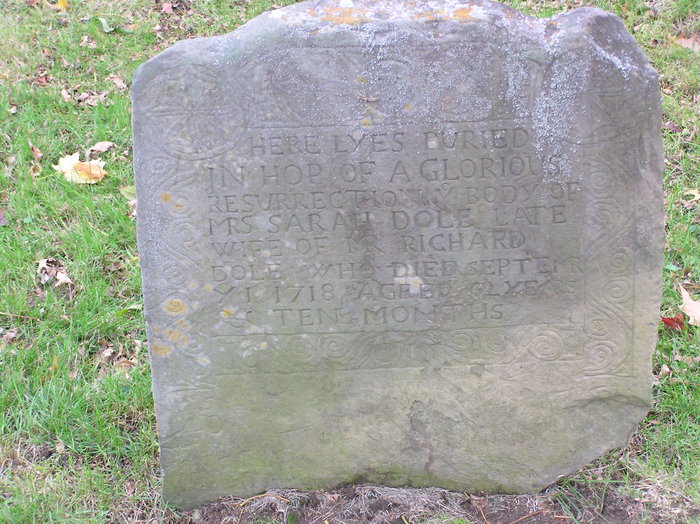
HERE LIES BURIED IN | HERE LYES BURIED
HOPS OF A GLORIOUS | IN HOP OF A GLORIOUS
RESURRECTION THE | RESURRECTION Ye BODY OF
BODY OF MR RICHARD | MRS SARAH DOLE LATE
DOLE WHO DIED | WIFE OF MR RICHARD
AUGUST YE 1 1720 | DOLE WHO DIED SEPTEMR
IN YE 73 YEAR | Ye 1 1718 AGED 62 YEARS
OF HIS AGE | TEN MONTHS
Andover (1818 - 1875)
|-Elijah Crowther |-John Howarth
Dorothy Lucinda Crowther-| |-James Howarth-|
|-Mary Eliza Howarth-|
|-Dorothy Stott
The Crowther and Howarth families were the last of MINNIE MAY WELCH's ancestors to immigrate to America. The Howarth family came to Andover, MA from England in 1818: JOHN HOWARTH, his three sons JAMES, Charles, and Isaac, and JAMES's wife DOROTHY STOTT and four children MARY, John, James Jr., and Thomas. In the 1820 census for Andover South Parish, James Howarth is listed as the head of the family with 10 people living in the house. In 1824 JAMES acquired interest in a stone mill on the east side of the Shawsheen River where he and Abijah Chase made flannel goods. When JAMES died in 1832 his son John carried on the business as John Howarth & Co. (Isaac, John, James Jr., and DOROTHY) until the mill failed in the financial crises of 1837. In 1843 the building was bought by Smith, Dove & Company, which became the largest flax manufacturer in Massachusetts and dominated the manufacturing community of Andover. The Howarth factory is shown on old maps of Andover, and their original stone mill building still exists (see photos below). JAMES' homestead included 14 acres with a house and barn adjacent to the mill. He died Spetember 1, 1832, and is buried in the South Church Burying Ground in Andover. His 1832 will names his wife DOROTHY, and children MARY, John, James, & Thomas, (who was still in school). DOROTHY lived another 43 years. She sold most of her husband's land to Isaac. The land with her dwelling was sold at auction in 1844 due to non-payment of a mortgage. According to the 1870 census, she lived with her son James, who was a prominent physician.
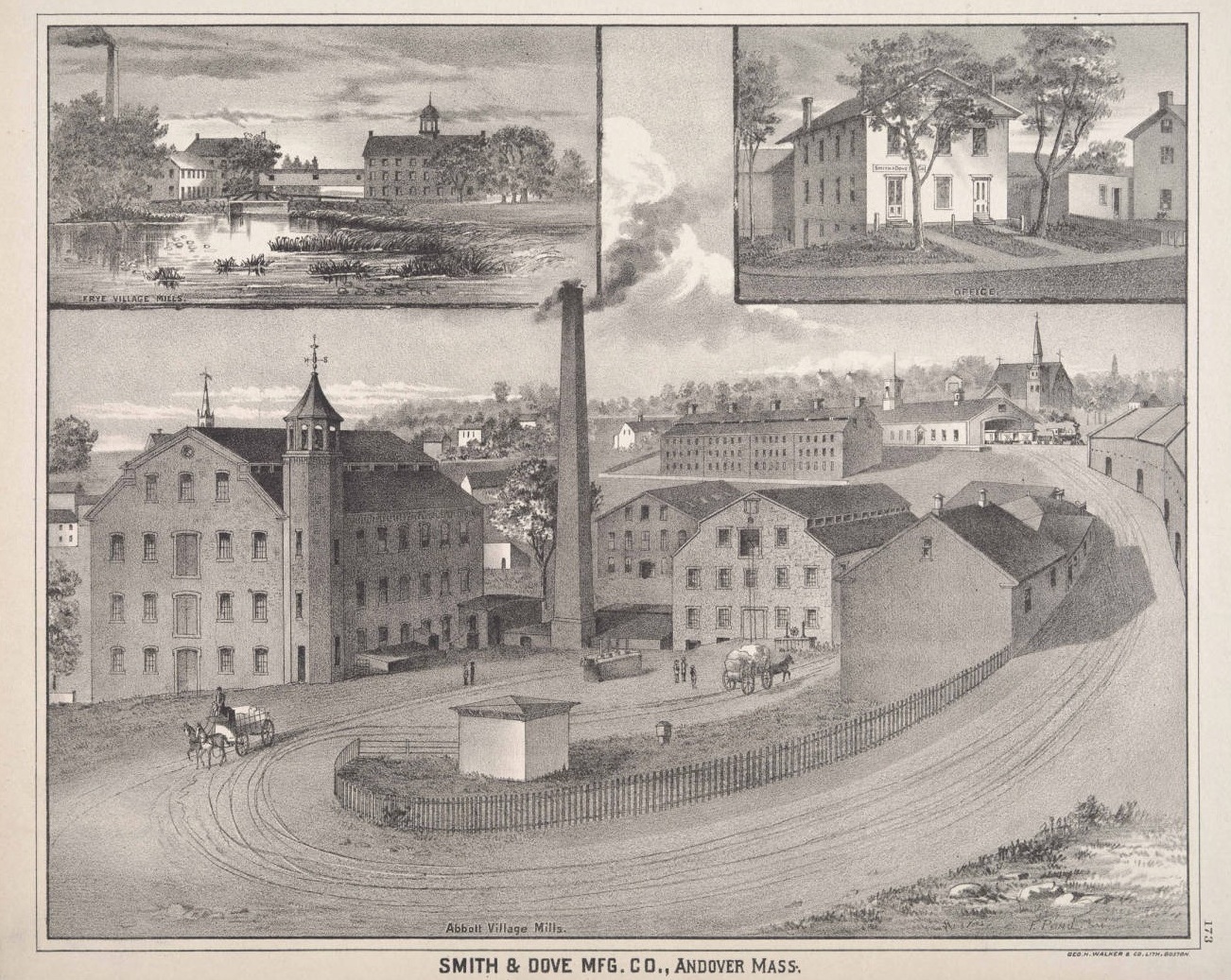
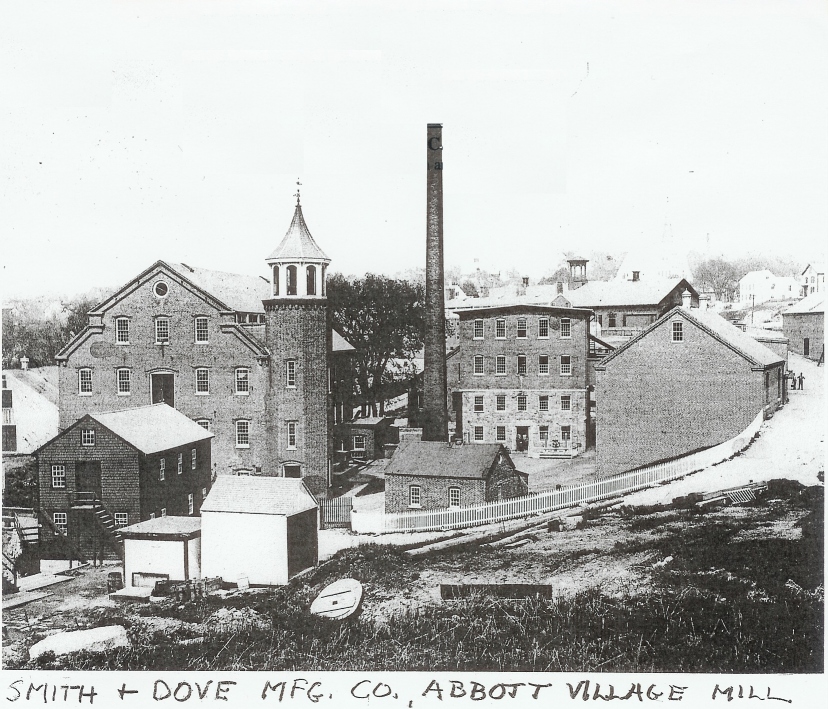



Howarth Mill amongst the Smith and Dove mills at Dundee Park
Left: before 1884 view of the Smith and Dove mills, with the 3-story stone Howarth mill building to the right of the tall smoke stack.
Middle: after 1894 view of the same buildings, showing the modifications to the stone building.
Right: 2013 views of the old Howarth Mill building from south, west, and northeast
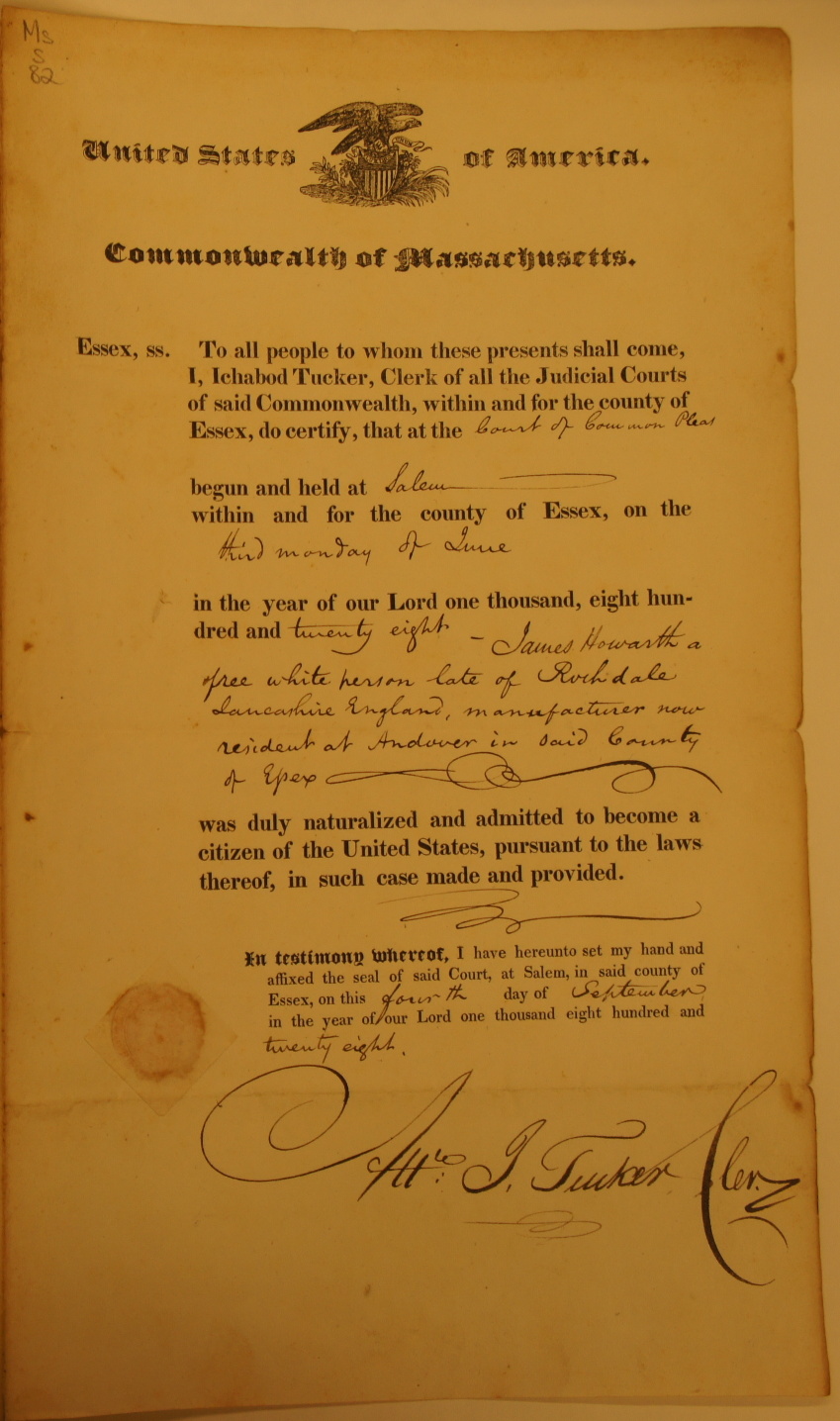
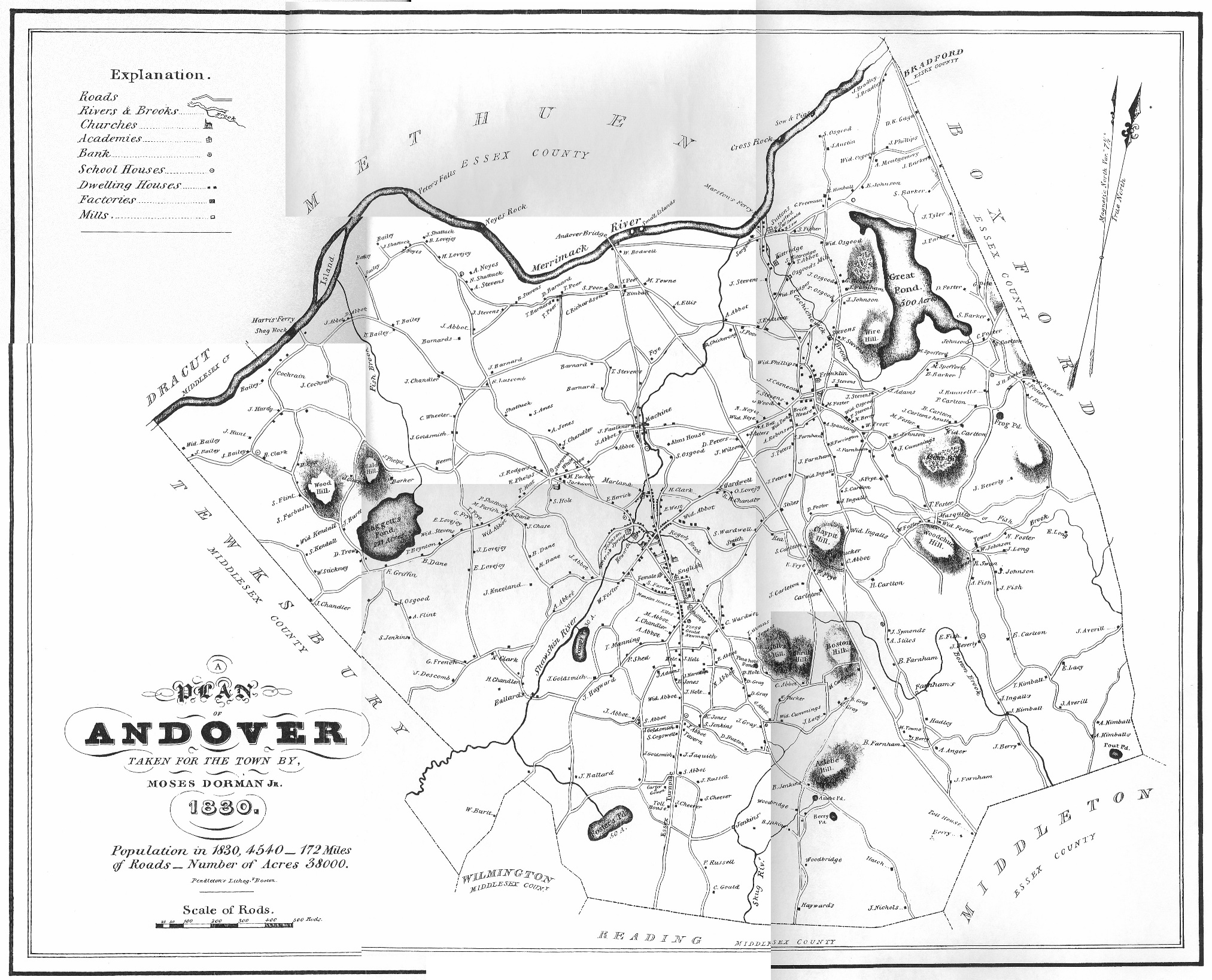
Right: 1830 map of Andover showing Howarth's factory on the east side of the river in the middle of the map.
MARY HOWARTH married ELIJAH CROWTHER in Andover on Jan 15, 1832. ELIJAH was born in Lancashire, England, and came to America in 1929. ELIJAH and MARY had six children born in Andover, including DOROTHY born March 29, 1847. Their youngest son, William, was born in 1845 and probably died young as there is no further mention of him. Daughter Mary was born in 1834, but died of consumption in Andover in 1859. The 1840 US Census lists the CROWTHERs in Andover as a family of five with one person engaged in manufatures and trades. Most of the years between 1834 and 1945 ELIJAH is listed in the South District, South Parish, Andover tax records. Sometime between 1847 and 1860 the family moved to Norwich, Connecticut. I tend to think they moved after Mary died, so ELIJAH only lived in Norwich for three years before dying in 1862. Andover would have still felt like home to him, and that is why he and MARY were buried in South Church Burying Ground in Andover, along with their son James and daughter Mary. (See the Connecticut chapter for more on the Crowthers).
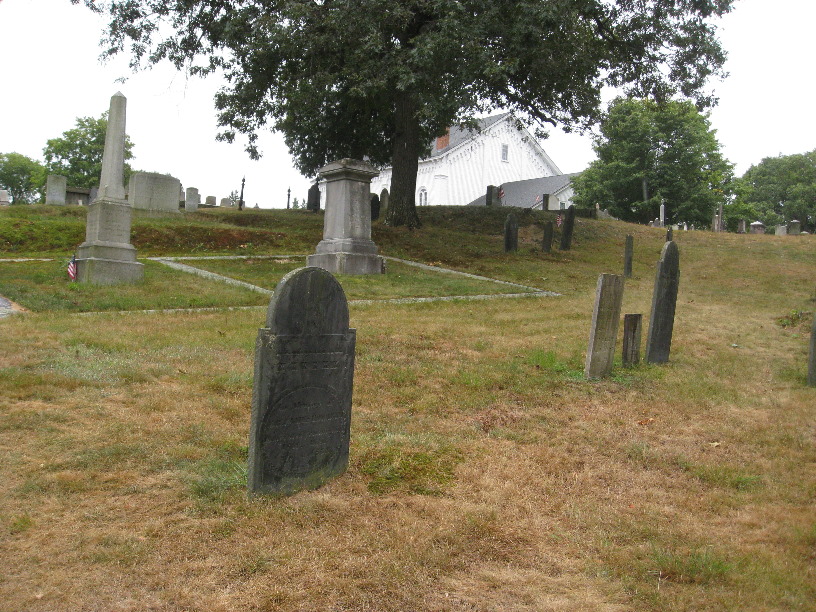
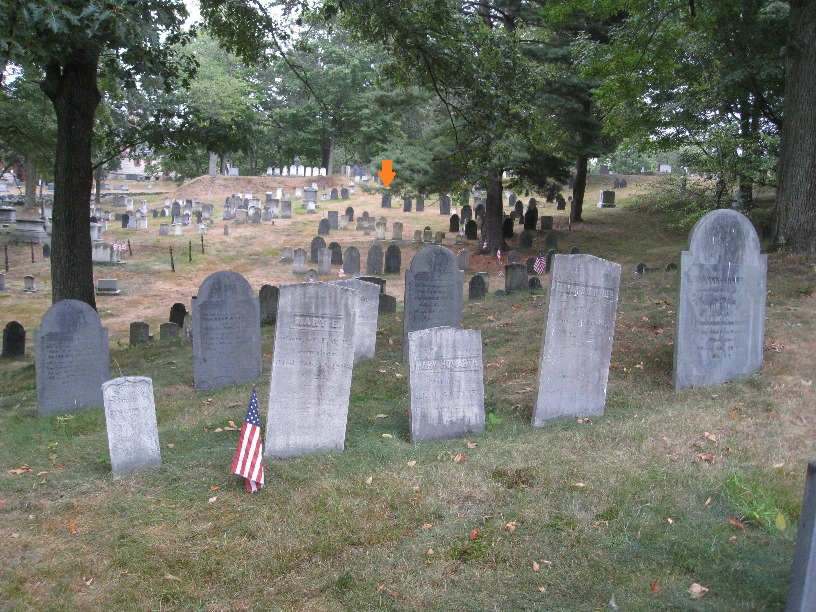
Left: plot #384 - gravestone for James Howarth. The fourth stone is for Benjamin Howarth, perhaps James' uncle.
Right: plot #195 - Mary Howarth Crowther and her husband Elijah Crowther are in the center. The stones to the left are their children James and Mary. The stone to the right is for Richard Crowther, probably Elijah's uncle or cousin. Orange arrow points to stone for James Howarth
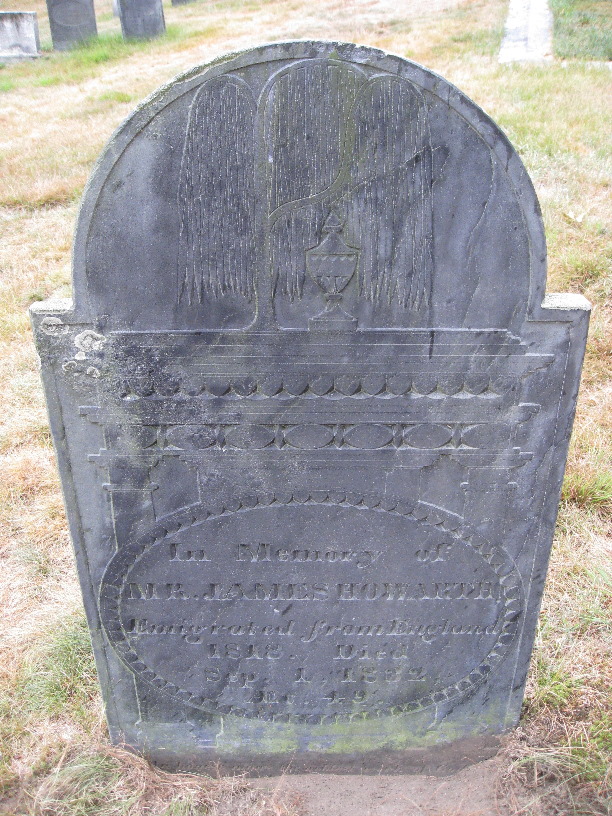
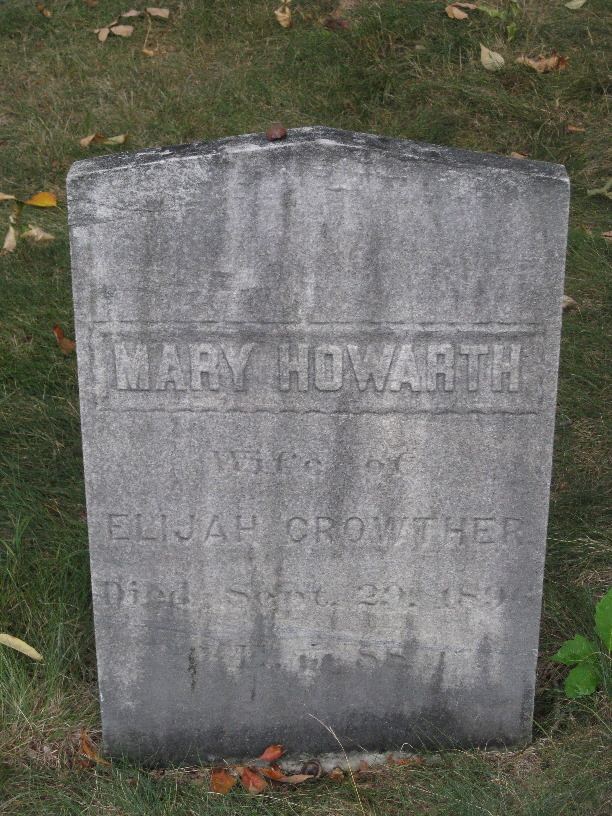
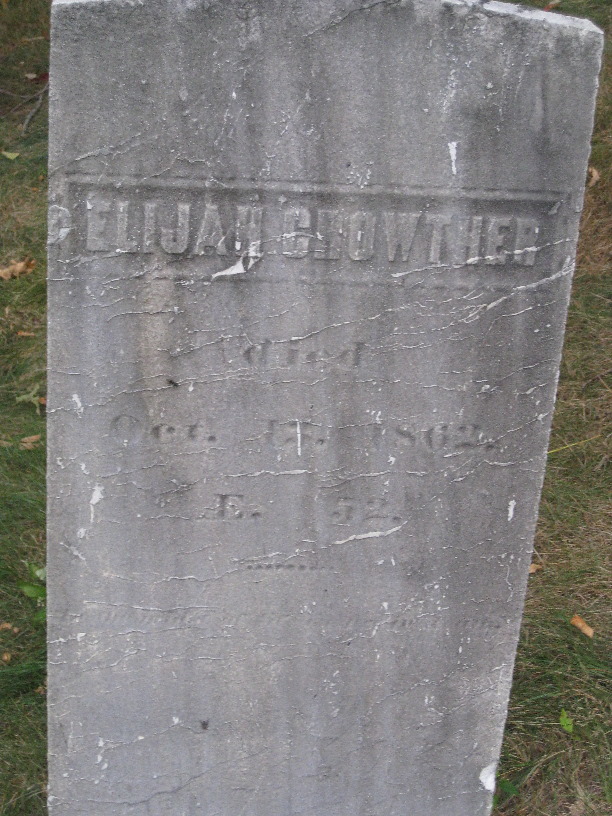
In Memory of | MARY HOWARTH | ELIJAH CROWTHER
MR. JAMES HOWARTH | Wife of | DIED
Emigrated from England | ELIJAH CROWTHER | Oct. 13, 1862
1818. Died | Died Sept. 20, 1896 | AE. 52
Sep. 1, 1832, | Aet. 88 | .........
AET . 49. | | (?)in our midst is
An honest man's the | | the xxx of death(?)
noblest work of God |
Bibliography (most of these books can be downloaded and read from Google Books):
- "Historical Sketches of Andover, Massachusetts" by Sarah Loring Bailey, 1880 (page 595)
- "Atlas of Essex County, Massachusetts", by George H. Walker & Co, 1884 (page 173 is lithograph of Smith & Dove Mfg. Co.)
- "The Historical Collections of the Topsfield Historical Society"
- "Historical collections of the Essex Institute, Vol 4"
- "Records and Files of the Quarterly Courts of Essex County, Mass"
- "Essex Institue Historical collections, Vol 54"
- "Vital Records of Marblehead, Massachusetts, Vol 3"
- "'Ould Newbury': historical and biographical sketches" by John James Currier
- "History of Nantucket county, island, and town" by Alexander Starbuck, 1969
- "Mary Coffin Starbuck and the Early History of Nantucket"by Roland L.Warren, 1987
- "Historical sketch of Salem, 1626-1879" by Charles Stuart Osgood and H.M.Batchelder, 1879
